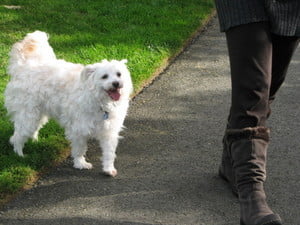Walking your dog is a wonderful way for both of you to have fun and become more attached to each other. It’s also a fantastic way for both you and your dog to stay fit and healthy.
Unfortunately, many people try repeatedly to take their dogs for a walk, but find it’s just not any fun. The dog pulls and drags his owner down the street, while the owner jerks and pulls back on the leash in an unsuccessful attempt to get the dog’s attention and slow him down. The dog’s neck gets sore and may even be damaged, while the owner’s shoulder feels like its being pulled out of its socket.
Often, this leads to a pattern of taking very short walks that just last long enough for the dog to relieve itself, and then it’s back in the house. Or, the dog is sent out to the back yard to do its business, and it never gets to go on a walk at all. Meanwhile, the dog’s owner tries one more time to get excited about exercising at the local gym, or buys another piece of exercise equipment that never gets used. Both the dog and the human miss out on one of the best reasons for their partnership, and their bond (and their health) suffers because of it.
If this has been a problem for you, there’s a better way. By using a training harness, you get the opportunity to start fresh, with a whole new set of rules for your dog, and a new attitude for yourself. I’ll talk about the different types of harnesses that are available, and how to choose one, a bit later in the book.
Training harnesses do give you a chance to start over, but dogs learn really fast – especially when they’re learning things on their own. That means that your dog will start pulling again just a few days after you start using his training harness if you don’t immediately begin to use a good leash training method.
The harness makes it easier for you to explain the new rules to your dog, but the harness itself won’t produce any miracles. You still need to use good training techniques if you want permanent results. The following paragraphs give you my impressions of several different brands of dog training harness, which I tried out on my dog Banjo.
Softouch SENSE-ible harness and Premier EasyWalk harness:
The Softouch SENSE-ible Harness from Softouch Concepts, Inc. and a similar dog training harness sold by Premier, the Gentle Collar people, are designed to prevent the oppositional reflex that causes a dog to pull on the leash. On both the Softouch and Premier harnesses, the leash is attached to the front of the harness. They are intended to be used only when the dog walks at your side in the heel position.
The Premier harness has a Martingale loop on the chest strap, which tightens when the dog pulls, which the dog would find uncomfortable. The Softouch harness does not have this loop, so it gives gentle direction to the dog behind his shoulder when leash, which is attached in front, is pulled tight by the dog.
I have to admit that neither I nor my dog Banjo was very excited about the Softouch harness. It was very difficult for me to adjust it to fit, and I was never able to get it to look like the drawing in the instructions. Also, the harness attachment is under the dog’s chest, so the buckle is difficult to see, making it hard to keep Banjo’s chest fur out of the buckle. It would be easier with a short-haired dog.
Since this harness style only works when the dog is at your side, if you would like to give your dog a bit more freedom so he can sniff things and explore a bit farther away from you, this type of harness will not work. That isn’t a design flaw, it’s just not how the harness was intended to be used.
The Walkezee harness:
The Walkezee harness is made in England and is used by many members of the Association of Pet Dog Trainers, by Hearing Dogs for the deaf, Registered Assistant Dogs, veterinarians and others who prefer a humane training aid to help their dogs walk politely on a leash. The chest strap of the Walkezee harness is padded to prevent chafing, and the leash is attached to a coupling which is in turn attached to rings on both sides of the harness. I was very favorably impressed with the quality of the harness.
The padded front chest strap tightens when the dog pulls, which is slightly uncomfortable to the dog. The chest strap relaxes as soon as the dog stops pulling, which gives your dog an automatic reward for good behavior.
Unfortunately, these harnesses are not yet sold in the United States, as far as I could tell, but you can order one online at http://www.walkezee.com/ They are also quite expensive. When the shipping from England is included, Banjo’s Walkezee harness and coupling cost $49.17 in US dollars.
If you have one of these harnesses, it will work well if you remember to continue your dog’s training. The signals it gives the dog are not painful, so don’t expect the harness to do your training for you. However, it definitely gives signals that the dog can recognize, and if you reward him when the leash is slack, he’ll quickly understand what you want him to do.
This harness is much easier to fit to the dog than the Softouch harness, and it’s made from very strong and sturdy materials. There was no difficulty in adjusting it to fit Banjo, and since the main clip is at the top of his back, it’s relatively easy to put on. However, it isn’t nearly as easy as the Sporn halter, which I tried next.
The Sporn training halter:
While I waited for the Walkezee harness to arrive I ordered a Sporn halter for Banjo. Of the three harnesses that we tried for this review, the Sporn halter turned out to be the easiest harness to use, and was the least expensive.
The unusual way that the webbing is wrapped under the front legs causes the pulling pressure from the leash to be focused under the dog’s shoulder (in his “armpit”) which the dog is not expecting. When the leash is slack there is no pressure anywhere on the dog, so it is very easy for the dog to know when he’s pulling and when he’s not.
It’s also very easy for the dog to accept the harness, since there are no bands around his chest or tummy. There is nothing to push against, so the oppositional reflex is not activated. If you use the correct training procedure, the dog quickly learns that forward movement happens only if the leash is slack. Sherpa sleeves cover the webbing in the area where it comes in contact with the dog’s tender underarm area, which prevents chaffing.
After trying all those harnesses, and spending over $100.00, I decided that the Sporn halter is the easiest, least expensive, and most effective training harness among the ones I tried. It isn’t a miracle worker, by any means – if you allow your dog to pull while wearing the harness, that’s what he’ll do. The harness is, however, an excellent training tool, and I strongly recommend it. It’s really easy to put on the dog, and you don’t have to adjust it to fit.


